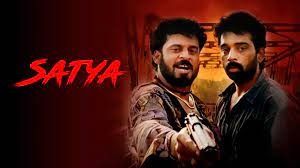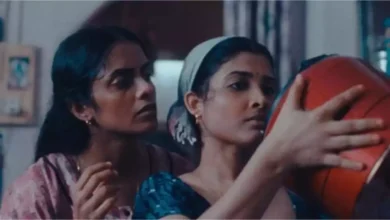‘Satya’s’ architectural geniuses are Anurag Kashyap and Saurabh Shukla
Ram Gopal Varma’s masterwork “Satya,” which released in 1998, has left a lasting influence on Indian cinema unlike few other films in the country’s history. The criminal thriller, which is based in the sleazy part of Mumbai, was a turning point for Bollywood in terms of narrative and the development of fresh talent. Beyond its grim narrative, “Satya” stands out for the uncommon teamwork that gave it life. By choosing lesser-known performers for the key parts and working with Anurag Kashyap and Saurabh Shukla to develop the screenplay, Ram Gopal Varma took a risk. This essay examines the intriguing background of “Satya,” the contributions of its talented authors, and the casting choices that marked the beginning of a new era in Indian film.
Before “Satya,” Ram Gopal Varma was known for consistently pushing the limits of Indian film. His 1990 feature film début, “Shiva,” received positive reviews from reviewers for its realistic portrayal of criminal activities and student politics in Hyderabad. But “Satya” was the movie that really marked a turning point in his professional life. The inspiration for the film came from Varma’s obsession with the Mumbai underworld, a subject that has previously been explored in Bollywood but never with such veracity.
Ram Gopal Varma recruited Anurag Kashyap and Saurabh Shukla to bring his idea of “Satya” to reality. Both are virtually unknown but very bright individuals. The drama “Zebunissa” by Kashyap, a young playwright at the time, was one that Varma had read and appreciated. Kashyap encouraged him to collaborate on the writing of “Satya” after seeing his talent. Given that Anurag Kashyap would eventually go on to become one of the most influential filmmakers in Indian cinema, recognized for his adventurous and bizarre storytelling, this decision was nothing short of prescient.
Saurabh Shukla, a well-known playwright and performer, was also included. By having a profound knowledge of character dynamics and the use of dark humor, he gave “Satya” greater depth. An effective working partnership between Kashyap and Shukla became the foundation for the film’s success.
Anurag Kashyap and Saurabh Shukla’s partnership helped to greatly influence “Satya.” During their months-long investigation into Mumbai’s criminal underground, the two really met criminals, got to know them firsthand, and learned about their mentality. “Satya” had an authenticity that was unrivaled in Bollywood at the time because of the extensive study.
They created a script that wasn’t like other Bollywood tales. It portrayed the terrible reality of life in the Mumbai underworld without glorifying it. The characters behaved out of need and desperation and had faults, but they were still human. The subtle narrative approach of “Satya” distinguished it from its peers and laid the path for a fresh, realism-embracing trend in Indian film.
When Ram Gopal Varma cast unknown performers in the key parts of “Satya,” he took one of the bravest decisions. Instead than depending on well-known performers, he went with fresh faces who could embody the harsh, authentic characters developed by Kashyap and Shukla. The outcome was a surprise.
J.D. Chakravarthy, an actor with no prior experience, was chosen to play Satya. He captured both the vulnerability and resilience of the character he portrayed, a man caught in the brutal world of crime. Manoj Bajpayee, another relatively unknown actor, played the terrifying Bhiku Mhatre with such conviction that it became a career-defining role. Urmila Matondkar, who was renowned for her gorgeous parts, experienced a tremendous shift in order to play the important character of Vidya.
It was a wise decision to hire performers who weren’t as well-known. It made it possible for viewers to connect with the characters more deeply since they were freed from the restrictions that come with viewing well-known actors. “Satya” was effective in immersing the audience in the seedy underbelly of Mumbai and making them forget that they were watching actors.
When “Satya” first came out in 1998, it was a surprise. Critics praised the film’s script, direction, and performances. It wasn’t simply a movie; it was a mirror reflecting the darkest side of metropolitan life. “Satya” created a new standard for Indian film and inspired a new generation of filmmakers to explore with realism and cutting-edge narrative methods.
Anurag Kashyap in particular become a significant presence in Indian film. With works like “Black Friday,” “Dev.D,” and “Gangs of Wasseypur,” he persisted in pushing the boundaries and solidified his image as a renegade filmmaker.
The success of “Satya” also helped Manoj Bajpayee launch a lucrative acting career. His depiction of Bhiku Mhatre helped him gain fame, and he later delivered standout performances in films like “Shool,” “Pinjar,” and “Aligarh.”
The film “Satya” offers evidence of the importance of collaboration and taking risks in the filmmaking process. the turn Indian film made when Ram Gopal Varma decided to use fewer well-known actors and entrusted Anurag Kashyap and Saurabh Shukla with the script. The movie’s true realism and captivating characters continue to captivate viewers decades after its premiere.
“Satya’s” legacy is felt beyond the big screen. It sparked a spark in the minds of filmmakers to create honest, unapologetic tales, and this spark produced many of them. Anurag Kashyap’s transformation from a little-known writer to a well-known filmmaker is evidence of this film’s capacity to effect change.
“Satya” will always be recognized as a groundbreaking film in Indian cinema history that dared to be different and, in doing so, profoundly altered Bollywood’s course. It still stands as a paradigmatic example of how bold choices in screenplay, casting, and narrative can have a lasting impact on the movie business.







